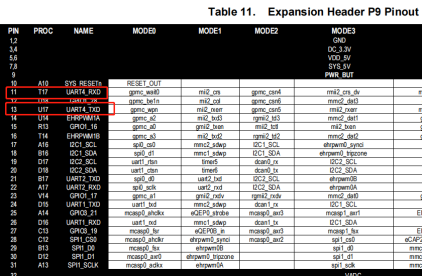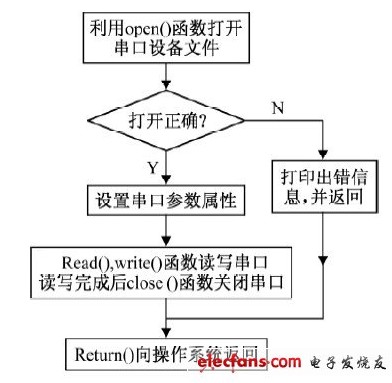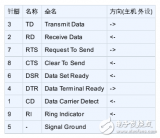1 背景
BB-BLACK是16年買的一塊開發(fā)板,時(shí)隔5年,板子上面卻看不到一絲歲月的痕跡,這兩天研究一下linux下串口的應(yīng)用開發(fā)。
2 所使用的鏡像文件以及rootfs
| 名稱 | 描述 |
|---|---|
| U-引導(dǎo) | bb-black-debian-u-boot.tar.bz2 |
| 內(nèi)核 | bb-black-debian-kernel-3.8.tar.bz2 |
| 根FS | prebuild-BBB-Exp-V2-eMMC-flasher-20140626.tar.gz/build/systems/Debian/rootfs.tar.gz |
3 硬件連接
選擇串口4

4 cape的使用
BB-BLACK的一些引腳功能,外設(shè)接口設(shè)備都可以通過cape來管理,我們要使用串口4設(shè)備,那就需要向這個(gè)cape中插入串口4設(shè)備
4.1 添加環(huán)境變量
export SLOTS=/sys/devices/bone_capemgr.9/slots
4.2 查看當(dāng)前設(shè)備
cat $SLOTS
0: 54:PF---
1: 55:PF---
2: 56:PF---
3: 57:PF---
4: ff:P-O-L Bone-LT-eMMC-2G,00A0,Texas Instrument,BB-BONE-EMMC-2G
5: ff:P-O-L Bone-Black-HDMI,00A0,Texas Instrument,BB-BONELT-HDMI
4.3 向cape中添加串口4設(shè)備
echo BB-UART4 > $SLOTS
4.4 檢查是否添加成功
ls ttyO*
ttyO0 ttyO4
4.5 設(shè)置波特率
stty -F /dev/ttyO4 115200
4.6 簡單測(cè)試收發(fā)
echo "test" > /dev/ttyO4
cat /dev/ttyO4
5 安裝輔助工具
基本的收發(fā)測(cè)試正常后就可以進(jìn)行應(yīng)用開發(fā)了,我們需要安裝一些工具來提高效率
5.1 掛載nfs文件系統(tǒng)
5.1.1 ubuntu下安裝nfs
sudo apt-get install nfs-kernel-server
sudo apt-get install nfs-common
5.1.2 設(shè)置路徑
/home/samba *(rw,sync,no_root_squash)
5.1.3 測(cè)試掛載
mount -t nfs 192.168.0.193:/home/samba /mnt -o nolock
如果報(bào)錯(cuò)提示報(bào)錯(cuò)可能是路徑不對(duì)、目錄權(quán)限問題
mount.nfs: access denied by server while mounting
192.168.0.193:/home/samba
5.2 安裝samba實(shí)現(xiàn)windows和ubuntu之間的文件共享
5.2.1 安裝samba
sudo apt install samba samba-common -y
5.2.2 配置samba
sudo mkdir /home/samba
sudo vim /etc/samba/smb.conf
[samba]
comment=samba
path = /home/samba
public = yes
writable = yes
create mask = 0777
directory mask = 0777
5.2.3 開機(jī)啟動(dòng)samba
systemctl enable smbd
5.2.4 啟動(dòng)samba
samba systemctl start smbd
5.3 安裝出錯(cuò)時(shí)可能需要重新配置一下dpkg
sudo dpkg --configure -a
sudo apt update
6 應(yīng)用測(cè)試
6.1 相關(guān)代碼
6.1.1 串口的配置、打開、關(guān)閉、讀寫接口
int uart_open(int fd,char*port)
{
fd = open( port, O_RDWR|O_NOCTTY|O_NDELAY);
if (fd<0)
{
perror("Can't Open Serial Port");
return(RES_UART_FALSE);
}
//恢復(fù)串口為阻塞狀態(tài)
if(fcntl(fd, F_SETFL, 0) < 0)
{
printf("fcntl failed!\\n");
return(RES_UART_FALSE);
}
else
{
printf("fcntl=%d\\n",fcntl(fd, F_SETFL,0));
}
return fd;
}
void uart_close(int fd)
{
close(fd);
}
int uart_config(int fd,int speed,int flow_ctrl,int databits,int stopbits,int parity)
{
int i;
int status;
int speed_arr[] = { B115200, B19200, B9600, B4800, B2400, B1200, B300};
int name_arr[] = {115200, 19200, 9600, 4800, 2400, 1200, 300};
struct termios options;
int res = tcgetattr( fd,&options);
if( res != 0)
{
perror("SetupSerial 1");
return(RES_UART_FALSE);
}
//設(shè)置串口輸入波特率和輸出波特率
for ( i= 0; i < sizeof(speed_arr) / sizeof(int); i++)
{
if (speed == name_arr[i])
{
cfsetispeed(&options, speed_arr[i]);
cfsetospeed(&options, speed_arr[i]);
}
}
//修改控制模式,保證程序不會(huì)占用串口
options.c_cflag |= CLOCAL;
//修改控制模式,使得能夠從串口中讀取輸入數(shù)據(jù)
options.c_cflag |= CREAD;
//設(shè)置數(shù)據(jù)流控制
switch(flow_ctrl)
{
case 0 ://不使用流控制
options.c_cflag &= ~CRTSCTS;
break;
case 1 ://使用硬件流控制
options.c_cflag |= CRTSCTS;
break;
case 2 ://使用軟件流控制
options.c_cflag |= IXON | IXOFF | IXANY;
break;
}
//設(shè)置數(shù)據(jù)位
//屏蔽其他標(biāo)志位
options.c_cflag &= ~CSIZE;
switch (databits)
{
case 5 :
options.c_cflag |= CS5;
break;
case 6 :
options.c_cflag |= CS6;
break;
case 7 :
options.c_cflag |= CS7;
break;
case 8:
options.c_cflag |= CS8;
break;
default:
fprintf(stderr,"Unsupported data size\\n");
return (RES_UART_FALSE);
}
//設(shè)置校驗(yàn)位
switch (parity)
{
case 'n':
case 'N': //無奇偶校驗(yàn)位。
options.c_cflag &= ~PARENB;
options.c_iflag &= ~INPCK;
break;
case 'o':
case 'O'://設(shè)置為奇校驗(yàn)
options.c_cflag |= (PARODD | PARENB);
options.c_iflag |= INPCK;
break;
case 'e':
case 'E'://設(shè)置為偶校驗(yàn)
options.c_cflag |= PARENB;
options.c_cflag &= ~PARODD;
options.c_iflag |= INPCK;
break;
case 's':
case 'S': //設(shè)置為空格
options.c_cflag &= ~PARENB;
options.c_cflag &= ~CSTOPB;
break;
default:
fprintf(stderr,"Unsupported parity\\n");
return (RES_UART_FALSE);
}
// 設(shè)置停止位
switch (stopbits)
{
case 1:
options.c_cflag &= ~CSTOPB; break;
case 2:
options.c_cflag |= CSTOPB; break;
default:
fprintf(stderr,"Unsupported stop bits\\n");
return (RES_UART_FALSE);
}
//修改輸出模式,原始數(shù)據(jù)輸出
options.c_oflag &= ~OPOST;
options.c_lflag &= ~(ICANON | ECHO | ECHOE | ISIG);
//options.c_lflag &= ~(ISIG | ICANON);
//設(shè)置等待時(shí)間和最小接收字符
options.c_cc[VTIME] = 1; /* 讀取一個(gè)字符等待1*(1/10)s */
options.c_cc[VMIN] = 1; /* 讀取字符的最少個(gè)數(shù)為1 */
//如果發(fā)生數(shù)據(jù)溢出,接收數(shù)據(jù),但是不再讀取 刷新收到的數(shù)據(jù)但是不讀
tcflush(fd,TCIFLUSH);
//激活配置 (將修改后的termios數(shù)據(jù)設(shè)置到串口中)
if (tcsetattr(fd,TCSANOW,&options) != 0)
{
perror("com set error!\\n");
return (RES_UART_FALSE);
}
return (RES_UART_TRUE);
}
int uart_init(int fd, int speed,int flow_ctrl,int databits,int stopbits,int parity)
{
int err;
//設(shè)置串口數(shù)據(jù)幀格式
if (uart_config(fd,speed,flow_ctrl,databits,stopbits,parity) == RES_UART_FALSE)
{
return RES_UART_FALSE;
}
else
{
return RES_UART_TRUE;
}
}
int uart_read(int fd, char *rcv_buf,int data_len)
{
int len,fs_sel;
fd_set fs_read;
struct timeval time;
FD_ZERO(&fs_read);
FD_SET(fd,&fs_read);
time.tv_sec = 10;
time.tv_usec = 0;
//使用select實(shí)現(xiàn)串口的多路通信
fs_sel = select(fd+1,&fs_read,NULL,NULL,&time);
//printf("fs_sel = %d\\n",fs_sel);
if(fs_sel)
{
len = read(fd,rcv_buf,data_len);
return len;
}
else
{
return RES_UART_FALSE;
}
}
int uart_write(int fd, char *send_buf,int data_len)
{
int len = 0;
len = write(fd,send_buf,data_len);
if (len == data_len )
{
printf("send data is %s\\n",send_buf);
return len;
}
else
{
tcflush(fd,TCOFLUSH);
return RES_UART_FALSE;
}
}
6.1.2 測(cè)試代碼
#include "stdint.h"
#include "app_usart.h"
#include "app_config.h"
#include "rtservice.h"
#include "ful_communication.h"
#includeuint8_t ch = rcv_buf[idx];
printf("%02x ",ch);
g_ful_com_detect_command(ch);
}
printf("\\n");
}
usleep(10000);
}
uart_close(fd);
close(fd_drv_uart);
}
6.1.3 生成文件
CFILE = $(wildcard *.c)
CFILE += $(wildcard functions/*.c)
CFILE += $(wildcard app/*.c)
DIRSRC += -I functions/include
DIRSRC += -I app/include
all:
@gcc $(CFILE) $(DIRSRC) -o u_app
#gcc *.c -o usart
.PHONY:clean
clean:
@-rm u_app
6.1.4 目錄結(jié)構(gòu)
app
--include
--app_test.c
--app_uart.c
functions
--include
--fun_communication.c
Makefile
u_app
6.3 串口應(yīng)用的開機(jī)自啟動(dòng)
開機(jī)自啟動(dòng),運(yùn)行在后臺(tái),u_app需要添加可執(zhí)行權(quán)限
cp u_app /usr/my_app
vim /etc/rc.local
./usr/my_app/u_app /dev/ttyO4 &
exit 0
6.4 測(cè)試
可正常解析指令,返回結(jié)果

7 總結(jié)
用虛擬機(jī)來跑ubuntu總是不太穩(wěn)定,如果不能進(jìn)入桌面系統(tǒng)也不能進(jìn)入tty控制臺(tái)基本上就要重裝了,還是得找個(gè)穩(wěn)定的ubuntu鏡像才行呀。
-
Linux
+關(guān)注
關(guān)注
87文章
11232瀏覽量
208949 -
串口
+關(guān)注
關(guān)注
14文章
1547瀏覽量
76230 -
開發(fā)板
+關(guān)注
關(guān)注
25文章
4959瀏覽量
97214 -
應(yīng)用開發(fā)
+關(guān)注
關(guān)注
0文章
58瀏覽量
9340 -
BB-Black
+關(guān)注
關(guān)注
1文章
15瀏覽量
13193
發(fā)布評(píng)論請(qǐng)先 登錄
相關(guān)推薦
基于Linux環(huán)境下串口通信的應(yīng)用設(shè)計(jì)
【教程】Linux下串口與工業(yè)協(xié)議開發(fā) - 2
【教程】Linux下串口與工業(yè)協(xié)議開發(fā) - 3
【教程】Linux下串口與工業(yè)協(xié)議開發(fā) - 4
【教程】Linux下串口與工業(yè)協(xié)議開發(fā) - 6
Linux下可用的串口助手在linux下使用串口終端
Linux下串口編程下載
Linux下ARM 和單片機(jī)的串口通信設(shè)計(jì)

基于WinCE_NET下串口驅(qū)動(dòng)開發(fā)設(shè)計(jì)

基于嵌入式linux系統(tǒng)下的串口編程具體設(shè)置詳解
【嵌入式Linux(環(huán)境篇)】Linux下的串口助手 —— minicom或putty





 linux下串口的應(yīng)用開發(fā)
linux下串口的應(yīng)用開發(fā)











評(píng)論